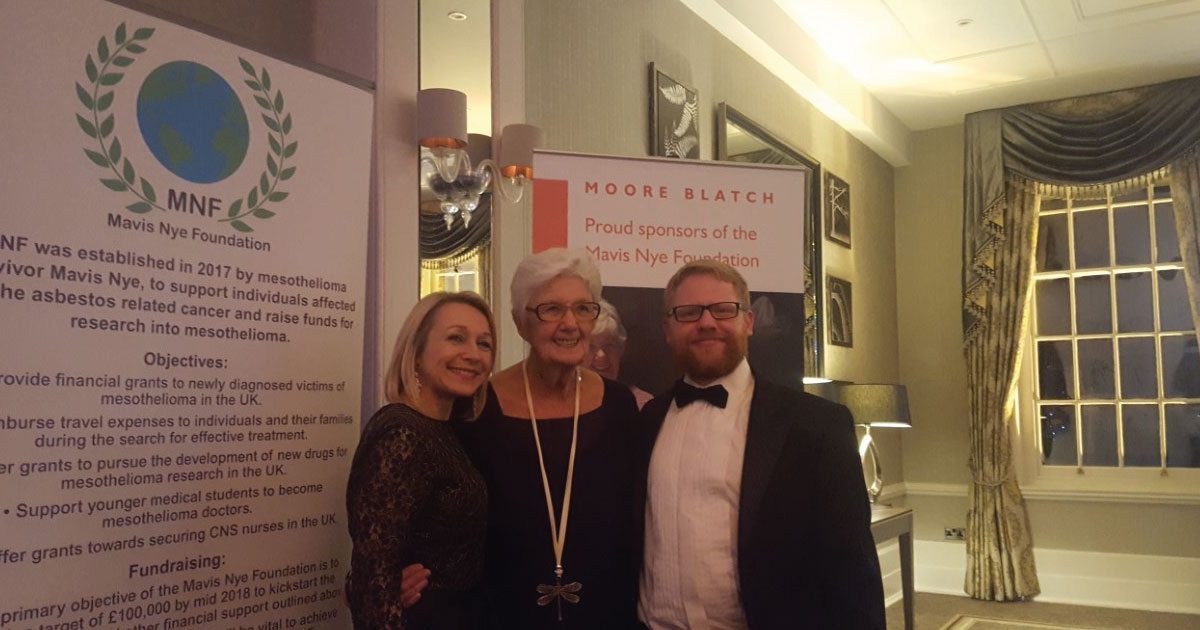Category: Research

Mesothelioma Drug Given Promising Innovative Medicine Status in the UK
Boehringer Ingelheim has announced that the UK is following in the footsteps of the U.S. in the latest designation for the company’s drug nintedanib. In December 2016, the U.S. Food and Drug Administration granted orphan drug designation to the investigational cancer drug for the treatment of mesothelioma. Now, the UK Medicine and Healthcare Products Regulatory Agency has designated nintedanib a Promising Innovative Medicine for the treatment of malignant pleural mesothelioma.
The PIM designation, according to Gov.UK, is an indication that the product may be eligible for the early access to medicines scheme (EAMS) that brings medicines to patients with life threatening conditions when there is an unmet medical need. The designation was assigned based on the encouraging results of the phase II/III LUME-Meso trial, according to a Jan. 4 PharmaTimes article.
“This is fantastic news and the right decision taking into account the risk/benefit profile of nintedanib from a very credible Phase II trial,” said Professor Dean Fennell, Chair of Thoracic Medical Oncology at the University of Leicester and University Hospitals of Leicester NHS Trust, UK, commenting on the decision.
Results from the LUME-Meso Trial showed “statistically significant improvements,” according to Pharma Times, with mesothelioma patients treated with the drug plus chemotherapy achieving 9.4 months of progression free survival compared to 4.7 months for those patients receiving chemotherapy alone.
Nearly 2,500 cases of pleural mesothelioma are diagnosed each year in the UK. With limited effective treatment options the median survival is less than 14 months. Reports indicate that nearly 3,000 Americans are also diagnosed with the deadly cancer each year. New, effective treatments are critically important to improve mesothelioma patient survival.
To find out more about the LUME-Meso trial, see ClinicalTrials.gov.
https://clinicaltrials.gov/ct2/results?term=%22malignant+mesothelioma%22&recr=Open&pg=1
Sources :
- U.S. Food and Drug Administration
http://www.mercknewsroom.com/news-release/oncology-newsroom/merck-announces-fda-acceptance-review-mk-3475-biologics-license-appli - Gov.UK
https://www.gov.uk/government/news/medical-innovation-doctors-and-patients-encouraged-to-give-views - PharmaTimes
http://www.pharmatimes.com/news/pim_status_for_boehringers_mesothelioma_drug_1215220

Improving Immune System’s Memory May Lead to New Mesothelioma Treatment
Mesothelioma patients often lose ground when fighting back against the deadly cancer due to a compromised immune system. Immunotherapy is one way oncologists and researchers use to awaken the immune system so it can successfully fight the cancer. Now, researchers report they may be able to stimulate the immune system’s ability to “remember” infections leading to new treatments that may better help fight disease.
Researchers from Monash University in Australia report they have discovered a “novel molecular ‘blueprint’” that could be the key to immunological memory, according to a Dec. 20 press release from Monash University’s Biomedicine Discovery Institute. The team found that when the immune system fights an infection, the B and T cells create memory cells. This memory is how immunity is developed and how vaccines work by mimicking that immunity.
B cells generate antibodies, whereas T cells are known as killer cells and destroy the invading sick cells. Using a strain of the flu, the researchers found the T cells, that the team called hit men, “are genetically wired to behave” the way they do. This finding broke new ground in understanding the changes T cells undergo when fighting an illness.
“What we found is there’s a specific sort of wiring that seems to characterise this type of immunological memory – it’s like an electrical circuit,” Professor Turner said. “We were able to identify specific ‘switches’ that are used in parts of the genome that actually give T cells their function.”
Mesothelioma, a signature cancer of asbestos, is extremely aggressive, and the cancer cells continue to grow and multiply as the patient’s immune system is compromised. Finding a way to wake up the immune system is critical for extending survival. Immunotherapy has been used successfully in some mesothelioma patients, however, this research points to another way to engage the immune system. In fact, Turner said, the “blueprint could serve as a benchmark for research, and potentially be used to hone and personalise therapies.”
Understanding immunological memory may help them improve existing treatments or create new ones that use the immune system to fight cancer, the researchers concluded.
The team will continue this research and reports the next step is to use the human influenza virus next.
Read the full study in the Dec. 19, 2017, issue of Cell Reports.

Libby, Montana Mesothelioma Doctors Contribute Knowledge to Medical Journals
The doctors at Libby, Montana’s Center for Asbestos Related Disease (CARD) know a thing or two about mesothelioma. The town is home to a vermiculite mine blamed for widespread contamination from asbestos exposure and for hundreds of cases of mesothelioma, and CARD has been the hub for care and screening of many of the patients. Now, the medical team is sharing their knowledge of this deadly disease through collaboration on articles for scientific journals.
Dr. Brad Black and Dr. Gregory Loewen, both physicians at CARD, were among the authors in two separate studies published recently in the peer-reviewed journals Inhalation Toxicology and the Journal of Occupational and Environmental Medicine (JOEM), according to a Dec. 29 article in The Western News. The two provided their expertise into the studies looking at the pulmonary function of miners at Libby’s vermiculite mine.
In the study of 256 individuals who worked at the mine for a minimum of six months, the researchers concluded “eighty-seven percent of miners exposed to Libby Amphibole had pleural abnormalities on CT [computed tomography].” The study was published in JOEM.
“… most doctors probably don’t know about this unique type of asbestos related disease and wouldn’t be able to recognize it in their patients if they didn’t hear about it,” said Dr. Black on why the study is important.
The W.R. Grace vermiculite mine and mill located in Libby, closed since 1990, was found to have an asbestos deposit in the mine and is the site of significant asbestos exposure. According to reports, nearly 3,000 residents and former miners have been diagnosed with an asbestos-related disease, and over 400 have died from mesothelioma. Contamination from the site led the federal government to declare Libby a health emergency.
Asbestos is a known carcinogen and is proven to cause mesothelioma, a serious cancer caused by breathing in the asbestos fibers that then become lodged in the thin membrane that lines and encases the lungs.
The second study followed one individual who worked at the mine from 1969 to 1990 and had no other known exposure to asbestos. The person developed “asbestos-like” pathological features and eventually an adenocarcinoma. According to the authors, “This is to our knowledge the first time such an extensive evaluation has been conducted in a vermiculite miner from Libby, Montana.”
About CARD
CARD’s primary goal is to provide specialty healthcare and screening to those affected by Libby Amphibole Asbestos. CARD’s secondary goal is to stimulate research from around the country to gain further understanding of disease mechanisms, improve early disease and cancer detection and intervention, and develop effective health management strategies in hope of finding answers to improve health outcomes for individuals and communities.
Find out more about the Center for Asbestos Related Disease on its website.
Read the studies in the Dec. 1 issue of the Journal of Occupational and Environmental Medicine and in the Oct. 17 issue of Inhalation Toxicology.
Sources:
- Center for Asbestos Related Disease
http://www.libbyasbestos.org/ - Inhalation Toxicology
http://www.tandfonline.com/doi/abs/10.1080/08958378.2017.1372536 - Journal of Occupational and Environmental Medicine
http://journals.lww.com/joem/pages/default.aspx
- The Western News
http://www.thewesternnews.com/front_page_slider/20171229/libby_asbestos_clinic_contributes_research_to_two_journals

Mavis Nye Takes Patient Empowerment to a New Level, Starts Foundation to Fund Mesothelioma Research
It has been nearly one year since Mavis Nye completed a life-saving clinical trial at the Royal Marsden in England. The 75-year-old British woman who has battled mesothelioma for the last eight years went from a frightened, sick patient lost in a medical maze, to the first UK patient to claim remission from the cancer.
Mavis fought nearly every step of the way to ensure that she got the right care at the right time that would help keep the cancer at bay and keep her alive. She has proven that a mesothelioma patient can regain her health and her life by taking control of her own care, and she showed that an empowered patient has the best chance at survival.
Throughout her fight, though, Mavis never gave up on her fellow mesothelioma warriors as she battled for care for them as well. She plans on continuing that fight for others as she takes the helm at the Mavis Nye Foundation (MNF).
“I will be leaving a wonderful legacy that was always a dream of mine to raise money for research so that I pay back for such wonderful treatment that has kept me alive!” Mavis told Mesothelioma Help.
Mavis worked with a variety of people, including Trevor Sterling, Partner for Medical Relations at Moore Blatch Solicitors of London, and one of the UK’s leading major trauma lawyers, to get the foundation off the ground.
On April 27, Sterling made the following announcement on Facebook:
“A couple of years ago I read about a wonderful lady who had miraculously won her fight against Mesothelioma (an aggressive terminal cancer). She was given 3 months to live yet 8 years on she has become the most prolific asbestos campaigner. So inspired I went to meet her at the Marsden – she and her husband Ray are the most incredible people. They deserve a legacy so I am so thrilled that we have this week established the Mavis Nye Foundation.”
The MNF gives Mavis a forum to continue all of the advocacy and education work she has been doing since diagnosed with pleural mesothelioma in 2009. Mavis, who received the prestigious British Citizen Award in the category of “Service to Healthcare” in January 2016, can now give back to the community that has cheered her on throughout her highs and lows.
“Mavis has turned her battle with mesothelioma into something positive, and is making her voice heard to educate people about this illness,” said Angela Caulfield in her nomination of Mavis to the British Citizen Award.
Mavis Nye, BCAh, now proudly adds President, Mavis Nye Foundation to her signature block. Ray Nye, Mavis’s husband who has been by her side for 57 years and has been her rock during her battle with mesothelioma, will take a place on the MNF as Vice Chairman and Trustee.
“I want people to see that you can live with a terminal illness and fight, but at the same time educate people about asbestos and the disease it causes,” said Mavis.
The Mavis Nye Foundation Supports Patients, Research and the Medical Community
Mavis has always been thankful for the medical care she received, and she credits every one of the medical team members she encountered for keeping her alive far beyond her expectations. But, she also realizes that not all patients have access to such good care.
In June 2016, Mavis completed the MK3475-28 two-year clinical trial at the Royal Marsden Hospital in London where she received the immunotherapy drug pembrolizumab, known as Keytruda in the U.S. For Mavis, the results gave her a new life, and, according to a March 10, 2017 article in The Lancet, the drug is a suitable treatment option for patients with malignant pleural mesothelioma offering a “substantial duration of response.”
“All I can say is that at The Marsden, and Dean Fennel [visiting Senior Lecturer in medical oncology at Bart’s and Cancer Research UK Clinician], they all call me the star of the immunotherapy. Jeremy Steel [Co-Director of Bart’s Mesothelioma Research] in a speech recently said that they look at my case to prove that immunotherapy can work,” said Mavis.
It is this kind of response that has Mavis enthused about “funding more trials,” championing research and encouraging young college students to take on a career in the medical profession with an eye towards caring for mesothelioma patients.
As president and founder of the foundation, Mavis will guide the organization to focus on three critical areas of mesothelioma: the patient, research, and the medical staff.
The MNF will offer the following support:
- Financial support to UK patients diagnosed with mesothelioma or other asbestos-related diseases requiring assistance to access medical treatment, in particular, experimental medical treatment.
- Grants for the advancement of laboratory and clinical research in the UK for the treatment of mesothelioma and other asbestos-related diseases.
- Assist in the treatment and care of persons suffering from mesothelioma by awarding scholarships or grants for attendance at British higher education institutions for health professionals in financial need who will focus on mesothelioma nursing in the UK.
“I have so many people contacting me about the Mavis Nye Foundation it’s just amazing how it has been accepted by others,” said Mavis. “Charities, support groups, and everyone is congratulating me.”
Many factors can influence a patient’s survival, but being empowered to find the right medical care and to proactively manage the mesothelioma is the strongest weapon in fighting the disease and improving the patient’s outcome. Mavis is living proof of that, and she is not planning on giving up on herself, or others, anytime soon.
“I’m 75 now and proud to have lived this long and I never thought 8 years ago I would,” said Mavis. “My next target is our 60th wedding anniversary in 3 years time –I want to make that.”
Work is ongoing to get the MNF website established and ready to accept donations. If you would like to make a donation to the Mavis Nye Foundation now, contact Mavis at [email protected].
Read more about Mavis and Ray’s Journey on MesotheliomaHelp:
- Mavis Nye Completes Life-Saving Clinical Trial, Leaves Mesothelioma Behind
- Clinical Trial Frees Mavis Nye of Mesothelioma
- The Man Behind the Mesothelioma Warrior: Ray Nye Discusses Caring for His Wife
- Mavis Nye Finds Her Voice and Fights for the Mesothelioma Community
Follow Mavis and Ray through the following links:
- A Diary Of A Mesowarrior Living With Mesothelioma
https://rayandmave.wordpress.com/2015/11/17/a-diary-of-a-mesowarrior-living-with-mesothelioma-scan-results-have-really-shocked/ - Onestop Mesothelioma
http://onestopmesothelioma.co.uk/index.html
Mavis donates all proceeds of her books to Mesothelioma UK to help raise funds for mesothelioma research. Order her books at Mavis and Ray’s Bookstore.
Sources :
- Mesothelioma UK
http://www.mesothelioma.uk.com/ - Mavis and Ray’s Bookstore
http://www.lulu.com/spotlight/nyeray7070 - British Citizen Award
http://britishcitizenawards.co.uk/mavis-nye/

Study Shows That Asbestos Risks Remain Decades After Industry Departs
An Italian study published back in May found that malignant mesothelioma cases tend to be concentrated around industrial facilities that use asbestos. A new Italian study finds that mesothelioma incidence near industrial areas remains high long after an asbestos-using industry ceases operations.
Asbestos is the only known cause of mesothelioma, an incurable cancer affecting the membranous lining of the lungs and abdomen. Most cases of mesothelioma are related to occupational asbestos exposure. Cement factories, shipyards, automotive plants, food processing facilities, power plants, and steel plants are among the major sources of occupational asbestos exposure.
Not all asbestos exposure, however, is directly attributable to a person’s work activities. People can also be environmentally exposed to asbestos in areas where asbestos industries operate.
One such area is Casale Monferrato in Northwest Italy, the former home of the Eternit asbestos-cement plant, which closed in 1986. An Italian court in 2012 convicted the plant’s owners of causing the asbestos-related deaths of more than 3,000 people. While many of those people worked at the Eternit plant, others merely lived near the plant.
Casale Montferro is the subject of a study published recently in Occupational & Environmental Medicine. The study authors identified 200 cases of pleural mesothelioma diagnosed in Casale Montferro residents between 2001 and 2006 in an effort to quantify the association between pleural mesothelioma and asbestos exposure.
They discovered that the odds ratio (OR, a measure of association between an exposure and an outcome) of an asbestos-exposed individual developing mesothelioma ranged from 4.4 to 62.1, with increased exposure over time resulting in a higher OR. Subjects never occupationally exposed to asbestos had a mesothelioma OR of 3.8 to 23.3, while an OR of around 2 was observed for people living in homes near buildings with large asbestos cement parts.
The findings draw attention to the fact that asbestos health risks linger in the environment long after asbestos industries vacate. In addition, they serve as a reminder that asbestos disease can occur in people who never directly handled asbestos on the job.
“Risk of [pleural malignant mesothelioma] increased with cumulative asbestos exposure and also in analyses limited to subjects non-occupationally exposed. Our results also provide indication of risk associated with common sources of environmental exposure and are highly relevant for the evaluation of residual risk after the cessation of asbestos industrial use,” write the study authors.
The Italian study has implications for America and other countries with a history of industrial asbestos use. U.S. asbestos use peaked in the mid-70s, but asbestos diseases, which have a latency period of 10-40 years or more, continue to kill an estimated 12,000-15,000 Americans.
But the United States, unlike Italy, has not banned asbestos. While both countries deal with the residual presence of asbestos-containing materials from a bygone industrial era, the United States is unique among industrialized nation for its ongoing importation and use of asbestos.
Anyone interested in taking part in the fight against asbestos should visit the EWG Action Fund website.

Free Mesothelioma Patient & Treatment Guide
We’d like to offer you our in-depth guide, “A Patient’s Guide to Mesothelioma,” absolutely free of charge.
It contains a wealth of information and resources to help you better understand the condition, choose (and afford) appropriate treatment, and exercise your legal right to compensation.
Download Now